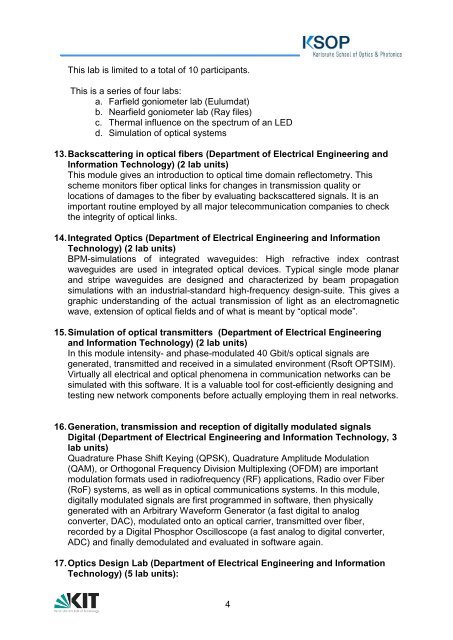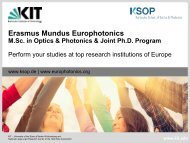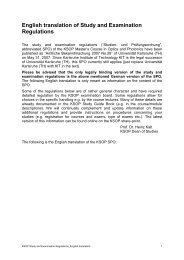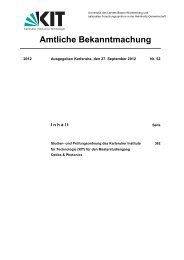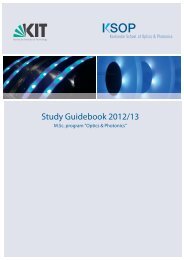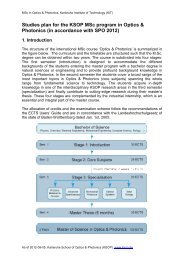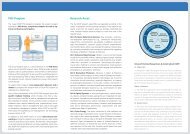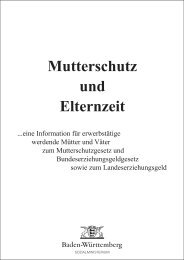Lab Descriptions - Karlsruhe School of Optics & Photonics - KIT
Lab Descriptions - Karlsruhe School of Optics & Photonics - KIT
Lab Descriptions - Karlsruhe School of Optics & Photonics - KIT
Create successful ePaper yourself
Turn your PDF publications into a flip-book with our unique Google optimized e-Paper software.
This lab is limited to a total <strong>of</strong> 10 participants.<br />
This is a series <strong>of</strong> four labs:<br />
a. Farfield goniometer lab (Eulumdat)<br />
b. Nearfield goniometer lab (Ray files)<br />
c. Thermal influence on the spectrum <strong>of</strong> an LED<br />
d. Simulation <strong>of</strong> optical systems<br />
13. Backscattering in optical fibers (Department <strong>of</strong> Electrical Engineering and<br />
Information Technology) (2 lab units)<br />
This module gives an introduction to optical time domain reflectometry. This<br />
scheme monitors fiber optical links for changes in transmission quality or<br />
locations <strong>of</strong> damages to the fiber by evaluating backscattered signals. It is an<br />
important routine employed by all major telecommunication companies to check<br />
the integrity <strong>of</strong> optical links.<br />
14. Integrated <strong>Optics</strong> (Department <strong>of</strong> Electrical Engineering and Information<br />
Technology) (2 lab units)<br />
BPM-simulations <strong>of</strong> integrated waveguides: High refractive index contrast<br />
waveguides are used in integrated optical devices. Typical single mode planar<br />
and stripe waveguides are designed and characterized by beam propagation<br />
simulations with an industrial-standard high-frequency design-suite. This gives a<br />
graphic understanding <strong>of</strong> the actual transmission <strong>of</strong> light as an electromagnetic<br />
wave, extension <strong>of</strong> optical fields and <strong>of</strong> what is meant by “optical mode”.<br />
15. Simulation <strong>of</strong> optical transmitters (Department <strong>of</strong> Electrical Engineering<br />
and Information Technology) (2 lab units)<br />
In this module intensity- and phase-modulated 40 Gbit/s optical signals are<br />
generated, transmitted and received in a simulated environment (Rs<strong>of</strong>t OPTSIM).<br />
Virtually all electrical and optical phenomena in communication networks can be<br />
simulated with this s<strong>of</strong>tware. It is a valuable tool for cost-efficiently designing and<br />
testing new network components before actually employing them in real networks.<br />
16. Generation, transmission and reception <strong>of</strong> digitally modulated signals<br />
Digital (Department <strong>of</strong> Electrical Engineering and Information Technology, 3<br />
lab units)<br />
Quadrature Phase Shift Keying (QPSK), Quadrature Amplitude Modulation<br />
(QAM), or Orthogonal Frequency Division Multiplexing (OFDM) are important<br />
modulation formats used in radi<strong>of</strong>requency (RF) applications, Radio over Fiber<br />
(RoF) systems, as well as in optical communications systems. In this module,<br />
digitally modulated signals are first programmed in s<strong>of</strong>tware, then physically<br />
generated with an Arbitrary Waveform Generator (a fast digital to analog<br />
converter, DAC), modulated onto an optical carrier, transmitted over fiber,<br />
recorded by a Digital Phosphor Oscilloscope (a fast analog to digital converter,<br />
ADC) and finally demodulated and evaluated in s<strong>of</strong>tware again.<br />
17. <strong>Optics</strong> Design <strong>Lab</strong> (Department <strong>of</strong> Electrical Engineering and Information<br />
Technology) (5 lab units):<br />
4


